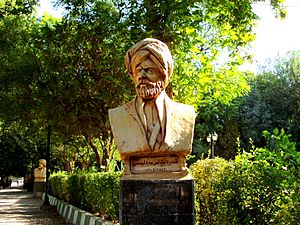Sharafkhan Bidlisi facts for kids
Quick facts for kids Sharafkhan Bidlisi |
|||||
|---|---|---|---|---|---|
| Emir, Mir and Khan | |||||
|
A portrait of Sharaf Khan Bidlisi
|
|||||
| Emir of Bitlis | |||||
| Predecessor |
|
||||
| Successor | Shamsaddin Beg Abulmalik | ||||
| Born | 25 February 1543 Karahrud, Safavid Iran |
||||
| Died | 1603–1604 (60–61 years old) | ||||
| Issue | Shamsaddin Beg Abulmalik | ||||
|
|||||
| Dynasty | Rojki | ||||
| Father | Shamsaddin Beg | ||||
| Mother | A daughter of Emîr Han Musullu | ||||
| Religion | Sunni Islam | ||||

Sharaf Khan Bidlisi was an important Kurdish leader and scholar. He was born on February 25, 1543, in a village in central Iran. He became the Emir of Bitlis, a powerful ruler of his time.
Besides being a leader, Sharaf Khan was also a talented historian, writer, and poet. He wrote all his works in the Persian language. His most famous book is called Sharafnama, which is a key source for understanding medieval Kurdish history. This book gives us a great look into Kurdish life and the different Kurdish ruling families in the 1500s. His writings have been translated and have influenced Kurdish culture even today. He was also skilled in math and military strategy.
Sharaf Khan's Early Life
Sharaf Khan Bidlisi was born in 1543 in Iran. His father, Shamsheddin, was a Kurdish leader. His mother came from a Turkic tribe called Mawsillu.
Sharaf Khan was part of the Rojki tribe. Members of this tribe ruled the Bitlis Emirate for many years. Because of his royal background, Sharaf Khan preferred the title of "emir" or "mir," which means "prince." He was often known as Mir Sharaf.
His family later received protection from the Safavid dynasty, a powerful empire. Sharaf Khan received a good education. He learned about the Quran and religious laws. He was taught to be kind and honest. As he grew older, he also learned important skills for a leader. These included martial arts, archery, polo, horse racing, and swordsmanship. He also learned about chivalry, which means being brave and generous.
Sharaf Khan's Rule
In 1576, the Safavid ruler, Shah Tahmasb, gave Sharaf Khan an important title. He was named "Mir of Mirs," making him the leader of all Iranian Kurdish tribes.
However, just two years later, Sharaf Khan changed his loyalty. He decided to support the Ottoman Empire in their war against the Safavids. He even sent 400 soldiers to help the Ottomans.
In 1578, the Ottoman Sultan, Murad III, made Sharaf Khan the Emir of Bitlis. From 1578 to 1588, Sharaf Khan played a big role in the Ottoman wars against the Persians. In 1597, Sharaf Khan passed his leadership to his son, Shams-al-Dīn.
The Sharafnama Book
Sharaf Khan Bidlisi had wanted to write a book about Kurdish history for a long time. He finally started writing his famous book, Sharafnama, in 1597.
The Sharafnama is divided into four main parts:
- The first part talks about five Kurdish ruling families that were like royalty. These include the Marwanids, Hasanwayhids, Fadluyids, and the Ayyubids, led by Saladin the Great.
- The second part lists ruling families who had their own coins and were mentioned in special Friday prayers.
- The third part describes families who were hereditary governors, meaning their leadership was passed down through generations.
- The fourth part tells the history of the mirs (princes) of Bitlis, Sharaf Khan's own family.
See also
- Kurdish history
- List of Kurdish dynasties and countries
- Mem and Zin

